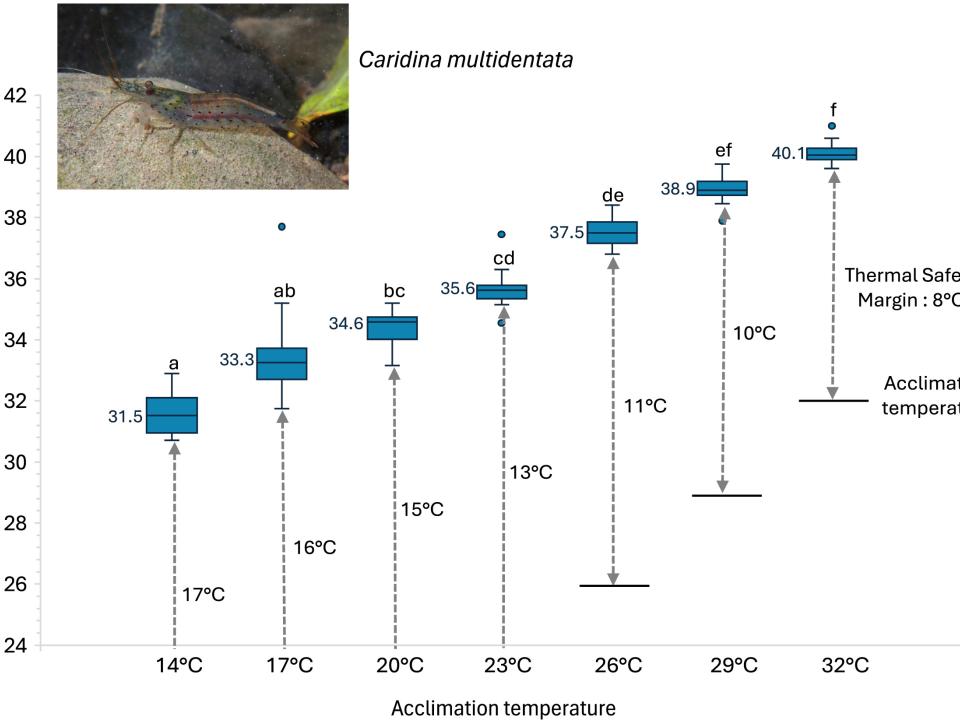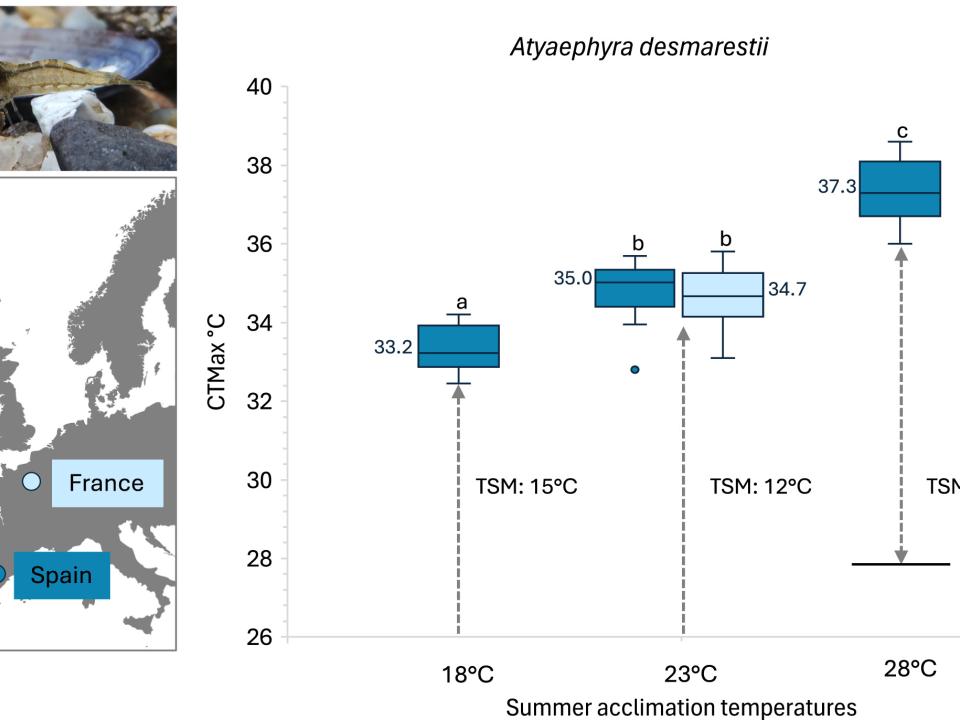Ravaux, J., Bosc, O., Fusari, C.-E., Gricourt, S.-M., Itin, M., Lestin, M., & de Mazancourt, V. (2025). Thermal tolerance and vulnerability to climate warming in the freshwater shrimp Atyaephyra desmarestii and Caridina multidentata. Journal of Thermal Biology, 129, 104121. https://doi.org/10.1016/J.JTHERBIO.2025.104121
Freshwater shrimp play crucial roles in aquatic ecosystems, yet their vulnerability to climate change remains poorly understood. This study investigates the thermal tolerance and vulnerability to climate warming of two important freshwater shrimp species with contrasting ecological preferences, Atyaephyra desmarestii and Caridina multidentata. Critical thermal maximum (CTMax) was assessed for different acclimation temperatures that cover the current summer range for both species, as well as for populations from different geographical origins for A. desmarestii. Both species demonstrated an excess of thermal tolerance in all conditions, as calculated with the thermal safety margins (TSM). However, the decrease of TSM with increasing acclimation temperatures suggested potential limitations in their ability to cope with future warming, particularly for the southern populations of A. desmarestii. Furthermore, while C. multidentata showed a high tolerance to extreme temperature fluctuations, it may face challenges in maintaining viable populations under projected climate change scenarios.
The present study also provides a survey of the thermal limits of Caridea, thereby highlighting the necessity for further research on the thermal tolerance of shrimp to inform effective conservation strategies and mitigate the impacts of climate change.
BOREA contact: Juliette Ravaux, juliette.ravaux@sorbonne-universite.fr
Picture title:
Fig. 3. Critical thermal maximum of Caridina multidentata acclimated to different temperatures. Data are represented as box plots, with whiskers indicating the minimum and maximum, the box delimiting the first quartile and third quartile, and the median and mean identified by an horizontal line (the value is shown next to the line). Each experiment was conducted on a sample size of n = 10 individuals. Values sharing a common letter are not significantly different (p > 0.05). The summer thermal safety margin (dotted lines) is calculated as the difference between the CTMax (for acclimation at 17 °C–26 °C since summer water temperatures are between 18 °C and 25°C; Yamada et al., 2024) and the habitat maximum water temperature (25°C; Yamada et al., 2024). Photo credit: Jacky Yu. © Ravaux et al.
Fig. 2. Critical thermal maximum of two populations of Atyaephyra desmarestii acclimated to different temperatures. Left panel: photograph of an A. desmarestii specimen (photo credits: V. de Mazancourt), and map showing the location of the sampling sites in France (Vitry-sur-Seine) and Spain (Flaça). Right panel: CTMax data are represented as box plots, with whiskers indicating the minimum and maximum, the box delimiting the first quartile and third quartile, and the median and mean identified by an horizontal line (the value for median and mean is equivalent and is shown next to the line). The experiments were conducted on a sample size of n = 9 (Spain, 28 °C), n = 10 (Spain, 18 °C), and n = 12 (Spain, 23 °C and France 23 °C) individuals. Values sharing a common letter are not significantly different (p > 0.05). The summer thermal safety margin (dotted lines) is calculated as the difference between the CTMax (mean) and the maximum water temperature (31 °C for Spain: Arbat-Bofill, 2015; 27 °C for France: Rivière et al., 2021). © Ravaux et al.






